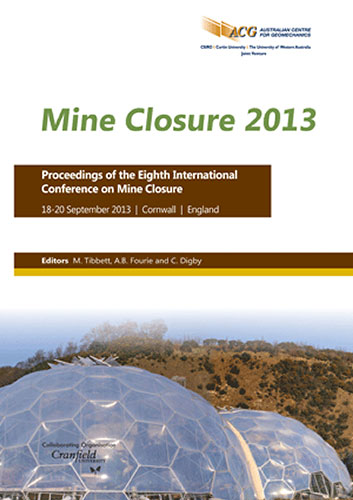Planning for closure – predicting mine site post-closure water quality within a Natura 2000 protection area in northern Scandinavia

|
Authors: Barnes, A; Johnson, S; Stewart, M |
DOI https://doi.org/10.36487/ACG_rep/1352_25_Barnes
Cite As:
Barnes, A, Johnson, S & Stewart, M 2013, 'Planning for closure – predicting mine site post-closure water quality within a Natura 2000 protection area in northern Scandinavia', in M Tibbett, AB Fourie & C Digby (eds), Mine Closure 2013: Proceedings of the Eighth International Seminar on Mine Closure, Australian Centre for Geomechanics, Cornwall, pp. 311-317, https://doi.org/10.36487/ACG_rep/1352_25_Barnes
Abstract:
Geochemical mixing models have been developed to simulate the post-closure water quality at a mine site in northern Scandinavia. Rivers in the vicinity of the site are a known habitat for the endangered sea trout (Salmo truter) and are within a Natura 2000 protection area under the 1992 EU Habitats Directive. Waste rock dump (WRD) seepage has been characterised though static and kinetic testwork of samples of fresh waste materials and weathered waste materials collected from existing WRDs and from multi-depth sampling from two existing pit lakes on-site. Samples collected from the existing WRD on-site show that there has been depletion of neutralising minerals within the material and that acidic conditions are developing within the dump. It is likely that WRDs are net-acid generating, and therefore suitable mitigation/ treatment measures will be required in order to minimise acid production to acceptable levels. The mine site layout has been designed such that all seepage from potentially acid WRDs is captured by pit dewatering and subsequently treated together with seepage from pit high wall. On cessation of mining, WRD seepage will continue to flow into the pit voids after groundwater levels have fully recovered, forming a point source rather than an uncontrolled diffuse source of seepage, which will aid post-closure mitigation and seepage control. There is predicted to be both groundwater and surface water discharge from the pit lakes, therefore treatment of pit lake discharge will be required to ensure discharge limits are achieved. Potential mitigation strategies include passive treatment through a wetland system or addition of chemical ameliorant directly to the pit lake for pH correction. Alternatively, loadings may be reduced at the source (WRD) by addition of a neutralising ameliorant (e.g. limestone) to attenuate acidity or by the application of a low-permeability, oxygen-limiting cover to the WRD to decrease metals load. Baseline water quality in the area is good with the exception of one watercourse that is negatively affected by uncontrolled releases of surface water from a historical tailings pond; water quality improves downstream of the tailings facility. During operations the tailings facility will be expanded. Water from the tailings ponds will be pumped away from the site, and surface water releases will cease. It is predicted that surface water quality in the immediate vicinity of the tailings facility will improve as a consequence. Following closure of the tailings facility, groundwater seepage and uncontrolled surface water releases have the potential to raise concentrations of some parameters above baseline values. Assessment of the potential for attenuation of tailings seepage within the clarification pond through the establishment of a wetland is suggested as a potential management option for post-closure mitigation of tailings seepage.
References:
ANZECC (Australian and New Zealand Environment and Conservation Council) and ARMCANZ (Agriculture and Resource Management Council of Australia and New Zealand) (2000) Australian and New Zealand guidelines for fresh and marine water quality, National Water Quality Management Strategy, Canberra, Australia, Vol. 1, Paper No. 4.
EU (European Union) (1992) Council Directive 92/43/EEC of 21 May 1992 on the conservation of natural habitats and of wild fauna and flora.
Parkhurst, D.L. and Appelo, C.A.J. (2012) PhreeqC version 2 – a computer program for speciation, batch-reaction, one dimensional transport and inverse geochemical calculations, US Geological Survey.
© Copyright 2025, Australian Centre for Geomechanics (ACG), The University of Western Australia. All rights reserved.
View copyright/legal information
Please direct any queries or error reports to repository-acg@uwa.edu.au
View copyright/legal information
Please direct any queries or error reports to repository-acg@uwa.edu.au